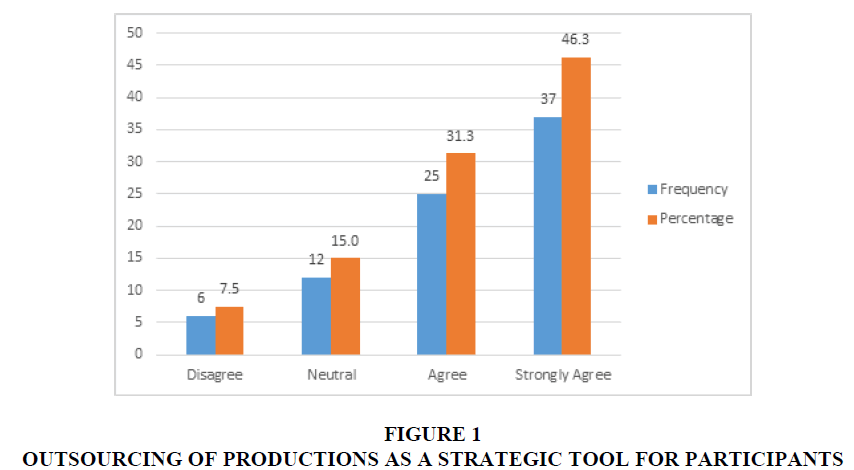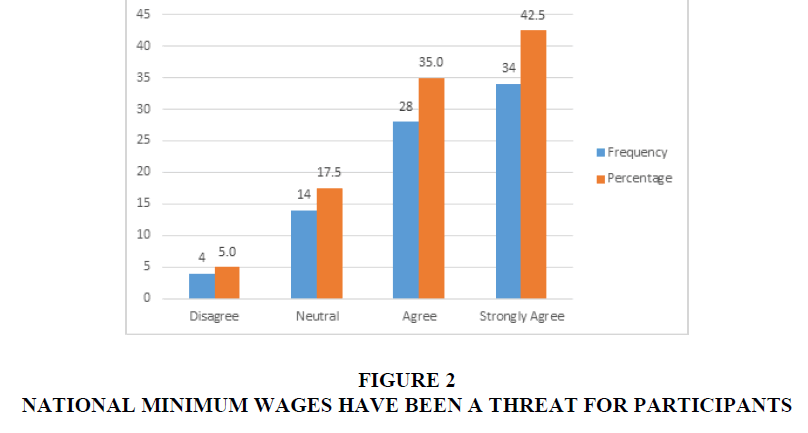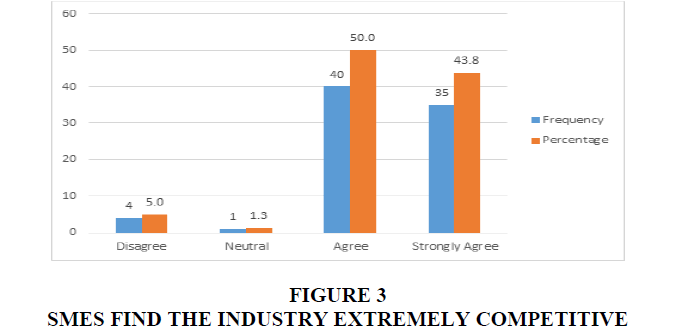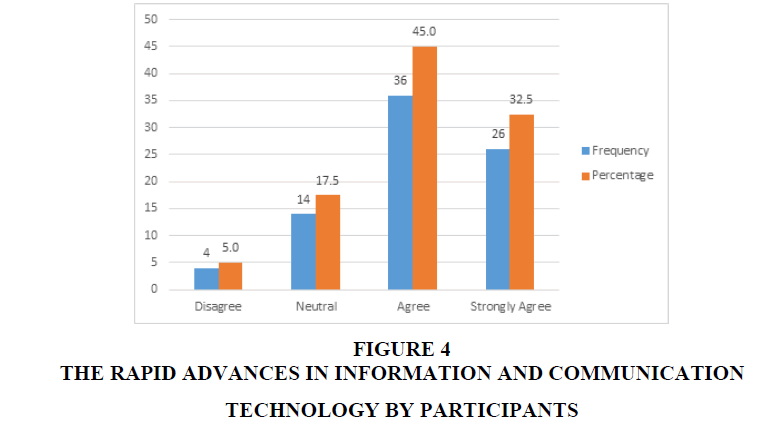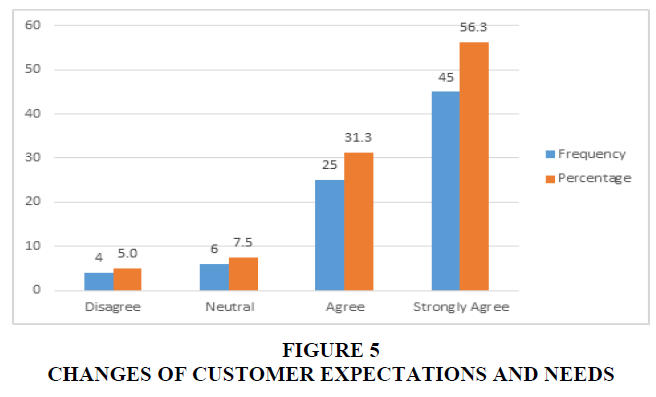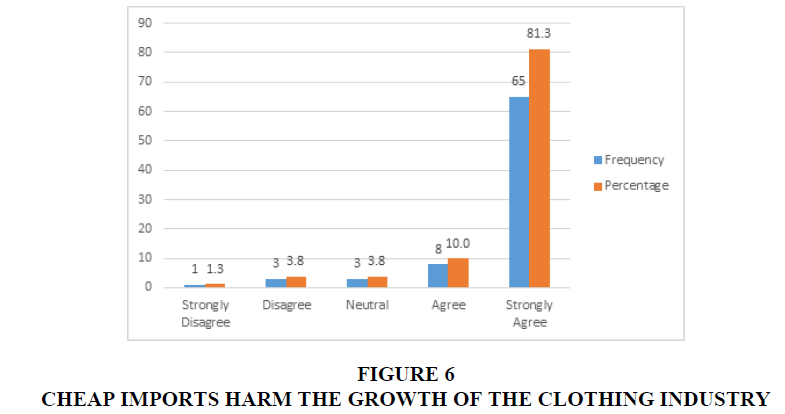Research Article: 2022 Vol: 28 Issue: 4
Factors Influencing the Competitiveness of Small and Medium Clothing Manufacturing Enterprises in the Ethekwini Municipal District in Kwazulu-Natal
Dalisu Mhlengi Mkhize, Durban University of Technology
Lawrence Mpele Lekhanya, Durban University of Technology
Citation Information: Mkhize, D.M., & Lekhanya, L.M. (2022). Factors influencing the competitiveness of small and medium clothing manufacturing enterprises in the Ethekwini municipal district in KwaZulu-Natal. Academy of Entrepreneurship Journal, 28(4), 1-16.
Abstract
This paper examines factors influencing the competitiveness of small and medium clothing manufacturing enterprises in the eThekwini municipal district in KwaZulu-Natal. SMEs in the clothing manufacturing industry remain at lower competency. This seems to be the act caused by the lack of knowledge and an understanding of the factors influencing their competitiveness (Lekhanya & Visser 2016). The study aimed to determine and examine factors influencing the competitiveness of SMEs and describe their influence among SMEs in the clothing manufacturing industry at the eThekwini Municipality District of KZN. The data was collected from different parts of eThekwini municipality which includes Durban central, South Coast of Durban, North Coast of Durban, and west parts of Durban. The sample consisted of 80 SME owners and managers of the clothing manufacturing companies who are members of the national bargaining council for clothing manufacturing industry at the eThekwini District. The research design embraces a quantitative research approach; a closed-ended questionnaire was distributed to the participants by the researcher. Due to the lockdown restrictions posed by COVID-19 (coronavirus), which resulted some participants restricting visitors, arrangements were made with those participants who do not allow visitors on their premises to complete questionnaires online, therefore, questionnaire were sent to them through emails. The data was analyzed using the Statistical Package for Social Sciences (SPSS) version 25 for Windows.
Keywords
Competitiveness, Clothing Manufacturing Industry, COVID-19, SMEs.
Introduction
The clothing manufacturing industry is of a great significant because of its significant contribution to economic growth, job creation and innovation. According to Ambe & Matsoma (2017) the clothing manufacturing industry has been a key to the economy by employing low skilled employees; it is one of the oldest sectors in the world. South African clothing manufacturing industry has been faced with international competitiveness since 1994, due to authorising trade with other countries.
(Satapathy, 2020) stated that although the drive to promote and support made in South Africa, South African clothing retailers are under a great growing pressure mainly due to international competitiveness, cheap imports from international countries such as China which makes clothing manufactured in South Africa more expensive, this has resulted from the South African clothing manufacturing industry to shed many jobs and closure of factories.
Problem Statement
SMEs are regarded as a significant contributor to economic growth, job creation, and innovation (Ayandibu & Houghton 2017). While SMEs contribute to the large firms as being the suppliers, they need to cope with factors that contribute to their competitiveness to maintain competitiveness (Taçolu, 2019). SMEs are also highly flexible, enabling them to respond quickly to the market and customer needs.
However, SMEs in the clothing manufacturing industry are still facing intense pressure to maintain competitiveness. The reason is due to inadequate government regulations, which have resulted in increased cheap importation from international markets, hence affecting local competitiveness; SMEs remain at lower competency. This seems to be the act caused by a lack of knowledge, and an understanding of the factors that contribute to their competitiveness (Lekhanya & Visser, 2016). Yet, OECD (2019); Thulo (2019) state that the 2018/19 SME South African report revealed some contributing challenges for SMEs such as access to markets with 52% of SME owners saying they need much assistance in this area. Entrepreneurs find the industries they are operating in highly competitive. South African SMEs face competitive pressure from illegal imports, poor planning, poor cash flow, and inefficient management skills have remained a critical factor that hinders their ability to grow and achieve competitiveness (Mugo et al., 2019).
Furthermore, even before the coronavirus outbreak and national lockdown, South African SMEs in the clothing industry has struggled to maintain competitiveness (Rajagopaul et al., 2020), highlighting the shock from COVID-19 putting much pressure on their operations and competitiveness. Hence, the inability to cope with competitive standards that change radically is also due to the customer changing needs, expectations, technological developments, and marketing globalization (Sitharam & Hoque 2016). SMEs' growth and achieving competitiveness are increasingly dependent on being able to cope with the changing factors contributing to their competitiveness.
Aims And Objectives
Aim
The aim of this study is to determine factors influencing the competitiveness of small and medium clothing manufacturing enterprises in the eThekwini municipal district in KwaZulu-Natal.
Objectives
• To identify factors contributing to the competitiveness of SMEs in the clothing manufacturing industry at the eThekwini Municipality District of KZN.
• To investigate how factors of competitiveness influence SMEs in the clothing manufacturing industry at the eThekwini Municipality District of KZN.
• To assist the SMEs of the eThekwini Municipality District of KZN within the clothing industry with improving the understanding of factors affecting their competitiveness.
• To suggest and recommend relevant factors that could be employed to improve the competitiveness of SMEs in the clothing manufacturing industry at the eThekwini Municipality District of KZN.
Literature Review
Overview of South African Clothing Industry
(Nattrass & Seekings, 2019) stated that the SA clothing industry, which also forms part of the SA manufacturing industry, is labor-intensive and plays a crucial role in the country's economic growth by creating jobs. The (OECD, 2019) reported that the clothing industry is collectively responsible for most of the employment (90 percent) and value-added (80 percent) to the CTFL industry. It employs approximately 95 000 workers, contributes eight percent to manufacturing GDP and nine percent to the country's overall GDP. The experience of the SA clothing industry is quite like that of other countries such as Bangladesh (Hossian et al., 2019), for instance, how competition escalated at an elevated level both locally and internationally after 1994 when the industry re-joined the global economy.
Definition of Competitiveness
Competitiveness means being able to win or be the best in the market in comparison to others of the same kind. Blas (2018) added that it is the ability of competing more successfully than others, while (Martinovi, 2018) defined competitiveness as "The ability of a firm to produce a unique strategy that adds value to its success". Bismala & Handayani (2017); Prasada et al. (2021) described competitiveness as derived from value creation; it is a tool used to create the value of the business and a barrier for competitors.
Determinants of Competitiveness
According to Mastamet-Mason (2018) the determinants of competitiveness are Porter's factor conditions, which refer to inputs necessary for production to occur and conducive for a company to gain competitive advantage. As explained by (Ergashxodjaeva et al., 2018), the enterprise's competitive advantage is mainly dependent on the competitive environment that is created in the enterprise. (Guan et al., 2018) state that there are numerous means an enterprise can use to determine a competitive environment. (Guan et al., 2018) added that factors of production are essential for the enterprise's competitiveness as the more adequate production factors. A study by (Matrutty et al., 2018) shows that improvement in living standards are considered a contributing factor in accelerating demands.
Factors Contributing to Competitiveness
Although labour cost is one of the significant variables influencing the competitiveness of the industry, (Taylor et al., 2021) further deliberated that labour costs impact the sector's performance in many ways, such as lack of exports, as experienced by the South African clothing manufacturing industry. Bibi et al. (2020) investigated the relationship between firm size and innovation, with the results indicating that firm size and creation positively influence a firm's competitiveness. In addition, (Führer & Michel, 2004) maintained that the size of a firm could be used as the key determinant of cooperative competitiveness. (Sibiya & Kele, 2019) find the importance of international market expansion by SMEs and stresses some challenges in accessing the foreign markets, these include a bureaucratic red tape hinders SMEs to access foreign markets.
Moreover, informal recruitment, lower wages, longer working hours, and unsafe working conditions remain as obstacles to achieving better working conditions (Islam & Islam, 2018; Khan et al., 2020). Muda & Rahman (2016) also stressed the importance of human capital to the business world; while (Susanto & Wasito, 2017) reviewed that the application of technological innovations is essential to ensure continuous improvement, hence, to achieve competitiveness. SMEs strongly depend on finance to grow, restructure, and innovate, with finance still seen as the key to any business becoming successful.
Competitiveness of SMEs in the South African Clothing Manufacturing Industry
It is asserted by Mohan (2018) that competitiveness could be achieved by deciding the firm's resources, also known as a resource-based view, so it can be noted whether the firm has potential resources to achieve competitiveness. Therefore, the ability of the firm to build competitiveness also depends on its resources and capabilities. However, due to a lack of financial resources, the shortage of industrial machines has negatively influenced the competitiveness of SMEs in the clothing manufacturing industry. Shen (2017) stated that most SMEs are not ready for emerging technologies, such as automation, due to the lack of finance and most believing it to be cheaper to hire foreign workers instead of implementing these technologies.
Research Methodology
The data was collected from different parts of eThekwini municipality which includes Durban central, South Coast of Durban, North Coast of Durban, and west parts of Durban. The sample consisted of 80 SME owners and managers of the clothing manufacturing companies who are members of the national bargaining council for clothing manufacturing industry at the eThekwini District. A literature review and objectives of the study was used as the source of information from which to formulate the questionnaire which consisted closed-ended questions.
The data was collected from different parts of eThekwini municipality which includes Durban central, South Coast of Durban, North Coast of Durban, and west parts of Durban. The sample consisted of 80 SME owners and managers of the clothing manufacturing companies who are members of the national bargaining council for clothing manufacturing industry at the eThekwini District. A literature review and objectives of the study was used as the source of information from which to formulate the questionnaire which consisted closed-ended questions.
The geographical area in which the respondent’s companies are located is illustrated in table 1.
| Table 1 Profile Of The Usable Sample |
||
|---|---|---|
| Geographic Area | ||
| Area | Frequency | Percent |
| South Coast of Durban | 19 | 23.8 |
| Durban Central | 33 | 41.3 |
| North Coast of Durban | 15 | 18.8 |
| Other | 13 | 16.3 |
| Total | 80 | 100 |
A literature review was used to develop the questionnaire, which was later used as the measuring instrument for this study. Table 2 summarizes the main questions used to collect primary data.
| Table 2 Summary Of Key Questions |
|
|---|---|
| Research Area | Question |
| High Labor Cost | High Labour cost has resulted in many SMEs in the clothing manufacturing industry outsourcing their production to neighbouring countries such as Lesotho for cheap labour. Response Alternative: Strongly Disagree; Disagree; Neutral; Agree; Strongly Agree. |
| National Minimum Wages | National minimum wages have been a threat for many SMEs in the clothing manufacturing industry. Response Alternative: Strongly Disagree; Disagree; Neutral; Agree; Strongly Agree. |
| Clothing industry is competitive | SMEs in the clothing manufacturing industry find the industry extremely competitive. Response Alternative: Strongly Disagree; Disagree; Neutral; Agree; Strongly Agree. |
| Importance of information and communication technology | The rapid advances in information and communication technology have contributed to the competitiveness of SMEs in the clothing manufacturing industry. Response Alternative: Strongly Disagree; Disagree; Neutral; Agree; Strongly Agree. |
| Customer Orientation | Customer expectations and needs are constantly changing in the clothing manufacturing industry, and this negatively affects SMEs. Response Alternative: Strongly Disagree; Disagree; Neutral; Agree; Strongly Agree. |
| Chep Imports | Cheap imports harm the growth of the clothing industry. Response Alternative: Strongly Disagree; Disagree; Neutral; Agree; Strongly Agree. |
Research Findings
Survey was conducted with various companies from different parts of eThekwini municipality district of KZN, Consisting of a total sample size of 80 companies. Analysis of data reveals the following.
Outsourcing of Productions as a Strategic tool for Participants
The study by (Leboea, 2017) reveals that South Africa’s neighboring countries such as Lesotho’s clothing industry creates more employment opportunities at a lower cost than any of its neighboring country. Figure 1 indicates that most respondents (46.3%) and (31.3%) agree that high labour cost has resulted in many SMEs in the clothing manufacturing industry outsourcing their production to neighbouring countries such as Lesotho for cheap labour. From the statement that was asked respondents are experiencing constantly changes in customer’s needs and expectations. Few of respondents (15%) remain neutral. While a very few of respondents (7.5%) disagree.
A correlation analysis of the results was performed to determine whether the intense pressure of competitiveness in the clothing manufacturing industry has a relationship association with high labour costs which has resulted in many SMEs to outsource their productions to neighbouring countries. The statistical results found no significant relationship between these two variables (X2 = 22.524a; df=9; p=0.007) this confirms null hypothesis between the two variables.
National Minimum Wages have been a Threat for Participants
According to Strauss et al. (2017) the implementation of a national minimum wage had been a threat to many SA companies from different industries. This has resulted in many clothing manufacturing firms outsourcing their production to countries that offer cheap labour, such as Lesotho and Swaziland. Figure 2 indicates that most respondents (42.5%) and (35%) agree that national minimum wages have been a threat for many SMEs in the clothing manufacturing industry. From the statement that was asked, national minimum wages have a negative impact on SMEs. Few of respondents (17.5%) remained neutral. While a very few of respondents (5%) disagree.
A correlation analysis of the results was performed to determine whether the intense pressure of competitiveness in the clothing manufacturing industry has a relationship association with effect of national minimum wages. The statistical results found a significant relationship between these two variables (X2=16.911a; df=9; p=0.050) this confirms an alternate hypothesis between the two variables.
SMES Find the Industry Extremely Competitive
According to (Bischoff & Wood, 2020) South African clothing manufacturing industry has faced intense competition from abroad; further reveal that most South African clothing manufacturing firms are battling to cope with competitiveness. Figure 3 indicates responses from different participants as whether SMEs in the clothing manufacturing industry find the industry extremely competitive. (50%) and (43.8%) of participants agree, while (5%) disagree and very few of respondents (1.3%) remain neutral.
A correlation analysis of the results was performed to determine whether the intense pressure of competitiveness in the clothing manufacturing industry has a relationship association with the case that SMEs in the clothing manufacturing industry find the industry extremely competitive. The statistical results found no significant relationship between these two variables (X2 = 34.053a; df=9; p=0.000) this confirms null hypothesis between the two variables.
The Rapid Advances in Information and Communication Technology by Participants
The rapid advance of ICT would open opportunities for businesses, which include smooth access to information, ease of processing and utilization of information (Putra et al., 2018). Figure 4 Illustrates that the rapid advances in information and communication technology have contributed to the competitiveness of SMEs in the clothing manufacturing industry as was indicated by (45%) and (32.5%) of respondents agreed that clothing manufacturing industry have benefited from ICT. While (17.5%) of respondents remain neutral and very few of respondents (5%) disagree.
A correlation analysis of the results was performed to determine whether the intense pressure of competitiveness in the clothing manufacturing industry has a relationship association with the contribution of ICT in the competitiveness of SMEs in the clothing manufacturing industry. The statistical results found a strong significant relationship between these two variables (X2 = 13.172a; df=9; p=0.155) this confirms an alternate hypothesis between the two variables.
Changes of Customer Expectations and Needs
Findings by Gonda et al. (2020) reveal that customer expectations and needs have a significant effect on business performance both direct and indirect through competitive advantage. Figure 5 indicates that most respondents (56.3%) and (31.3%) agree that customer expectations and needs are constantly changing in the clothing manufacturing industry, and it negatively affects them. From the statement that was asked respondents are experiencing constantly changes in customer’s needs and expectations. Few of respondents (7.5%) remain neutral. While a very few of respondents (5%) disagree.
A correlation analysis of the results was performed to determine whether the intense pressure of competitiveness in the clothing manufacturing industry has a relationship association with the constantly changes of customer expectations and needs in clothing manufacturing industry. The statistical results found a strong significant relationship between these two variables (X2 = 9.760a; df=9; p=0.370) this confirms an alternate hypothesis between the two variables.
Cheap Imports Harm the Growth of the Clothing Industry
According to most SA clothing manufacturers have been struggling to cope with the worldwide competition due to cheap import. (Miao et al., 2020) also reveal that China has been exporting manufactured garments to African countries cheaply for many years. SME manufacturers find it exceedingly difficult to make and sell their products because of these cheap imports. Figure 6 indicates that most respondents (81.3%) and (10%) agree that cheap imports harm the growth of the clothing industry. From the statement that was asked respondents are suffering greatly from cheap imports. Few of respondents (3.8%) and (1.3%) disagree. While a very few of respondents (3.8%) remain neutral.
A correlation analysis of the results was performed to determine whether the intense pressure of competitiveness in the clothing manufacturing industry has a relationship association with cheap imports harming the growth of the clothing manufacturing industry. The statistical results found a strong significant relationship between these two variables (X2=7.685a; df=9; p=0.809) this confirms an alternate hypothesis between the two variables.
Limitations
This study did not cover all companies in all municipality districts in KZN and other provinces of South Africa and was limited to only one municipality district. Therefore, the results of the study cannot be generalized to all South African companies. Due to the size of South African geographic profiles, it was difficult to research every company in every province; therefore, further research needs to include a large sample of other companies in other provinces.
Recommendations
It is evident from the findings that competitiveness of the clothing manufacturing industry is challenged by various factors which hinder small businesses to cope with competitiveness. Therefore, this study recommends that SMEs to be considered competitive, they should design their strategies to compete with various factors which include better working conditions for workers and should pay attention on purchasing conducive and quality inputs to gain competitive advantage.
Conlcusion
The conclusions of this study are grounded on the key findings. Additionally, conclusions also cover the aim and objectives of the study. Key findings of this study find that increasing labour cost, cheap imports can be viewed as the major determinants of the increasing lack of competitiveness of South African clothing manufacturing industry.
References
Ambe, I., & Matsoma, N. (2017). Demand planning approaches employed by clothing industry stakeholders in Gauteng, South Africa. Journal of Transport and Supply Chain Management, 11(1), 1-9.
Indexed at, Google Scholar, Cross Ref
Ayandibu, A.O., & Houghton, J. (2017). The role of small and medium scale enterprise in local economic development (LED). Journal of Business and Retail Management Research,11(2).
Bibi, S., Khan, A., Qian, H., Garavelli, A.C., Natalicchio, A., & Capolupo, P. (2020). Innovative climate, a determinant of competitiveness and business performance in Chinese law firms: the role of firm size and age. Sustainability,12(12), 4948.
Indexed at, Google Scholar, Cross Ref
Bischoff, C., & Wood, G. (2020). Survival and outsourcing in the South African clothing and textiles industry: The changing fortunes of ClothTran. In Case Studies in Work, Employment and Human Resource Management.
Indexed at, Google Scholar, Cross Ref
Bismala, L., & Handayani, S. (2017). Improving competitiveness strategy for SME’s through optimization human resources management function. Proceedings of AICS-Social Sciences, 7, 416-424.
Blas, A. (2018). The competitiveness of the Spanish clothing industry.
Ergashxodjaeva, S.J., Kyvyakin, K.S., Tursunov, B.O., & Ahmadovich, H.Z. (2018). Evaluation of textile and clothing industry clustering capabilities in Uzbekistan: based on model of M. Porter. International Journal of Economies Management Science, 7(439), 2.
Führer, C., & Michel, J. (2004). An empirical study of firm size and competitiveness in German life insurance. Journal for the Entire Insurance Science, 93(2), 251-267.
Indexed at, Google Scholar, Cross Ref
Gonda, G., Gorgenyi-Hegyes, E., Nathan, R.J., & Fekete-Farkas, M. (2020). Competitive factors of fashion retail sector with special focus on SMEs. Economies, 8(4), 95.
Indexed at, Google Scholar, Cross Ref
Guan, Z., Xu, Y., Jiang, H., & Jiang, G. (2018). International competitiveness of Chinese textile and clothing industry–a diamond model approach. Journal of Chinese Economic and Foreign Trade Studies.
Indexed at, Google Scholar, Cross Ref
Hossian, M.S., Kabir, R., & Latifee, E.H. (2019). Export competitiveness of Bangladesh readymade garments sector: Challenges and prospects. International Journal of Research in Business and Social Science, 8(3), 45-63.
Indexed at, Google Scholar, Cross Ref
Islam, S., Islam, T.N., & Freelance Researcher, M.B.A. (2018). Insights into the skill development issues of management jobs: A study on RMG and textile sectors of Bangladesh. Asian Social Science,14(12), 56-66.
Indexed at, Google Scholar, Cross Ref
Khan, M., Sulaiman, R., Nazir, O., & Ahmad, W. (2020). Small size, bigger impact: Do SMEs care about social responsibility in Pakistan? In Corporate Social Responsibility in Rising Economies, 73-89.
Leboea, S.T. (2017).The factors influencing SME failure in South Africa(Master's thesis, University of Cape Town).
Lekhanya, L.M., & Visser, K. (2016). Risks and factors contributing towards rural entrepreneurial orientation growth of business in an emerging economy. Risk Governance & Control: Financial Markets & Institutions.
Indexed at, Google Scholar, Cross Ref
Martinovi, M. (2018). Competitiveness through consumer loyalty: The influence of switching costs. In 6th International OFEL Conference on Governance, Management and Entrepreneurship. New Business Models and Institutional Entrepreneurs: Leading Disruptive Change. April 13th-14th, 2018, Dubrovnik, Croatia. 177-191.
Mastamet-mason, a. N.N.E. (2018). Chapter nine analysis of apparel manufacturing industries using porter’s factor condition determinant: A case study in kwazulu-natal. The Arts and Indigenous Knowledge Systems in a Modernized Africa, 138.
Matrutty, E.S., Franksisca, R., & Damayanti, T. (2018). SMEs Competitiveness in an integrated economy: A Preliminary Study from Indonesia. Oradea Journal of Business and Economics, 2, 7-16.
Indexed at, Google Scholar, Cross Ref
Miao, M., Yushi, J., & Borojo, D.G. (2020). The impacts of China–Africa economic relation on factor productivity of African countries. Economies, 8(2), 47.
Indexed at, Google Scholar, Cross Ref
Mohan, N. (2018). Using resource-based view strategy for a competitive advantage. Available: https://www.saviom.com/blog/using-the-resource-based-view-strategy-for-competitive-advantage/
Muda, S., & Rahman, M.R.C.A. (2016). Human capital in SMEs life cycle perspective. Procedia Economics and Finance, 35, 683-689.
Indexed at, Google Scholar, Cross Ref
Mugo, A.N., Kahuthia, J., & Kinyua, G. (2019). Effects of infrastructure on growth of small and medium enterprises in Kenya: A case of clothing and textile businesses in Nairobi Central Business District. International Academic Journal of Human Resource and Business Administration, 3(6), 133-149.
Nattrass, N., & Seekings, J. (2019).Inclusive Dualism: Labour-intensive development, decent work, and surplus labour in Southern Africa.
Indexed at, Google Scholar, Cross Ref
OECD. (2019). OECD SME and Entrepreneurship Outlook 2019.
Prasada, P., Febrian, E., Komaladewi, R., & Zusnita, W. (2021). Competitiveness of SMEs: The support of value creation and market orientation. Management Science Letters,11(2), 645-656.
Indexed at, Google Scholar, Cross Ref
Putra, D.A., Jasmi, K.A., Basiron, B., Huda, M., Maseleno, A., Shankar, K., & Aminudin, N. (2018). Tactical steps for e-government development. International Journal of Pure and Applied Mathematics, 119(15), 2251-2258.
Rajagopaul, A., Magwentshu, N., & Kalidas, S. (2020). How South African SMEs can survive and thrive post COVID-19. Providing the Right Support to Enable SME Growth Now and Beyond the Crisis.
Satapathy, D. (2020). S Africa sees R-CTFL master plan, industry revival efforts.
Shen, N.M. (2017). Manufacturing SMEs need funds, mindset change for Industry 4.0.
Sibiya, V., & Kele, T. (2019). Barriers and public policies impeding SMEs’ international market expansion: A South African perspective. International Journal of Entrepreneurship, 23(1).
Sitharam, S., & Hoque, M. (2016). Factors affecting the performance of small and medium enterprises in KwaZulu-Natal, South Africa. Problems and Perspectives in Management,14(2), 277-288.
Strauss, I., Isaacs, G., & Capaldo, J. (2017).The impact of minimum wage increases on the South African economy in the Global Policy Model. International Labour Organization.
Susanto, A.B., Wasito, W. (2017). Improve the performance Of SMEs through innovation strategies in developing countries. International Journal of Scientific & Technology Research 6(10), 282-285.
Taçolu, C., Ceylan, C., & Kazançolu, Y. (2019). Analysis of variables affecting competitiveness of SMEs in the textile industry. Journal of Business Economics and Management, 20(4), 648-673.
Indexed at, Google Scholar, Cross Ref
Taylor, M., Jack, R., Madsen, T., & Alam, M.A. (2021). The nature of service characteristics and their impact on internationalization: A multiple case study of born global firms. Journal of Business Research,132, 517-529.
Indexed at, Google Scholar, Cross Ref
Thulo, L. (2019). South Africa’s SMEs Landscape Report.
Received: 04-Apr-2022, Manuscript No. AEJ-22-11908; Editor assigned: 06-Apr-2022, PreQC No. AEJ-21-11908(PQ); Reviewed: 18-Apr-2022, QC No. AEJ-21-11908; Revised: 22-Apr-2022, Manuscript No. AEJ-21-11908(R); Published: 25-Apr-2022
